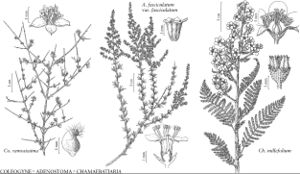Adenostoma
Bot. Beechey Voy., 139. 1832.
| Taxon | Illustrator ⠉ | |
|---|---|---|
 | Coleogyne ramosissima Adenostoma fasciculatum var. fasciculatum Chamaebatiaria millefolium | Marjorie C. Leggitt Marjorie C. Leggitt Marjorie C. Leggitt |
Shrubs, erect to rounded-spreading, 8–60 dm; developing enlarged woody lignotubers. Stems 1–10+, erect to arching or spreading, branched, terete or decurrently grooved; bark of red brownish papery layers, weathering gray; short-shoots present or absent; hirtellous, pilose, or glabrous. Leaves persistent, cauline, alternate, sometimes opposite, juvenile 1–2-pinnatifid, mature simple; stipules reduced or absent; petiole present or absent; blade linear to terete or linear-oblanceoloid, (0.2–) 0.3–1.4 (–2.6) mm, leathery or not, base persistent, clasping, truncate, margins revolute, entire, abaxial surface glabrous or sessile-glandular. Inflorescences terminal, 2–400+-flowered, panicles well branched, pyramidal or racemes or spikes reduced to cylindric, glabrous or hirtellous; bracts present; bracteoles present. Pedicels absent or relatively short. Flowers 2–6 mm diam.; hypanthium cylindric to campanulate, inner rim annular gland thickened, undulate, 0.6–2.4 mm, glabrous or hirtellous; sepals 5, erect to reflexed, valvate, broadly ovate to semiorbiculate; petals 5, white becoming rusty brown, obovate-orbiculate or elliptic to ovate, base clawed; stamens 10 or 15 in groups of 2 or 3 alternate with petals, shorter than petals; carpels 1 (or 2), distinct, obliquely truncate distally, glabrous or sericeous, styles lateral, each bending over ovary, erect distally, stigmas capitate to truncate; ovules 1 (or 2). Fruits achenes, 1 (or 2), obovoid or ellipsoid, 1.1–1.8 (–2.4) mm, hirtellous distally (exposed part); hypanthium persistent; sepals persistent, moreorless spreading; styles not persistent. x = 9.
Distribution
Calif., nw Mexico
Discussion
Species 2 (2 in the flora).
Adenostoma is a Madro-Tertiary derivative of a lineage with compound leaves. Seedlings and sucker shoots have 1–2-pinnatifid leaves; mature leaves are simple, undivided. Both species occur in chaparral and resprout after fires from basal lignotubers. The single achenes are derived from ancestral 5-follicled fruits, each carpel retaining the ancestral marginal style. Stamens are arranged in groups of 2 to 3 alternate with petals; filaments expand sequentially, first 5 (1 opposite each sepal), followed by the second 5 and third 5 (when 15).
Selected References
None.
Lower Taxa
Key
| 1 | Leaves crowded on short shoots, blades dark green, adaxial surfaces glabrous; stipules present on long-shoot leaves; subtending flower bracts 3-lobed, medial lobe largest; bracteoles 2, subulate; stamens (10–)15. | Adenostoma fasciculatum |
| 1 | Leaves on slender long shoots (short-shoot fascicles absent), blades yellow-green, adaxial surfaces sparsely hirtellous and sessile-glandular; stipules absent; subtending flower bracts linear-subulate; bracteoles 5 or 6, outermost subulate, inner oblong-obovate; stamens 10(–12). | Adenostoma sparsifolium |
"thin" is not a number.